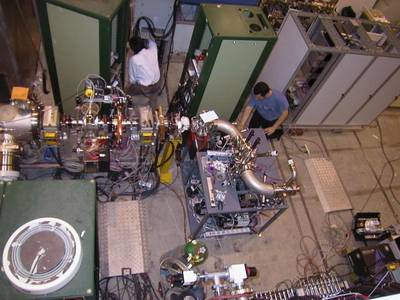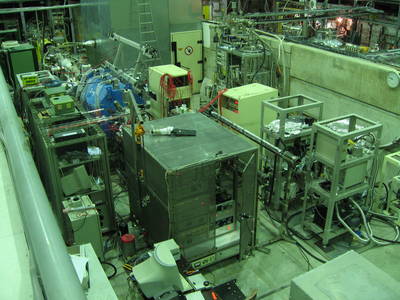Antiparticles are "the mirror image" of ordinary elementary particles. For example, the POSITRON is the antiparticle of the ordinary electron. Being the electron's antiparticle, the positron has the same mass as the electron, but it's electric charge has the opposite sign. Likewise with the ANTIPROTON: It has the same mass as the ordinary proton, but a negative charge.

When charged particles collide with atoms or molecules, the electric (Coulomb-)force between the projectile and the charged constituents of the target may lead to the ejection of one or more target electrons, which leaves the target "ionized". In this process, the projectile loses some of it's energy. These two phenomena: Ionization and energy loss are very important in several fields of physics. For example, ionization is what creates the plasma that exists in the stars, and in the man-made machines where "Fusion" research is pursued. The energy lost by charged projectiles during their passage of solid matter eventually ends up as defects in the target, and may ruin it's properties. The energy loss eventually leads to absorption of the projectile, and therefore, ionizing radiation can be shielded by (heavy) solids to protect living beings or apparatus.
In order to understand these processes, and to be able to calculate their probabilities, the atomic collision theorists create complicated quantum mechanical theories, and in order to make sure that these theories are correct, we MEASURE the probabilities for ionization and energy loss and other processes. To test the theories, it is important that we can vary freely the parameters that define the collision, such as the projectile mass, the projectile charge, the projectile velocity, and so on. Here lies the argument for using antiparticles as projectiles: If we compare the probability for, say double ionization of helium for impact of protons and antiprotons of equal velocity, the only parameter that is not the same is the projectile charge: One projectile is positive (and attracts the target electrons), the other is negative (and therefore repels the target electrons). Likewise we can use equivelocity positrons and protons to change only the projectile mass.
The antiprotons used in our work are created at CERN near Geneva, where we work together with colleagues from many other countries, formerly in the PS194 collaboration, now with the ASACUSA collaboration. We use the so-called AD ( = Antiproton Decellerator) machine, which produces slow antiprotons. These antiprotons are further slowed down in the so-called RFQD (Radiofrequency quadrupole decelerator) and in the socalled MUSASHI superconducting Penning trap..
During 2000 and 2001 we have had two runs at the AD where we measured the stopping power of slow antiprotons in several materials. The energy of the antiprotons was as low as 1 keV (!).Here you see a picture of our experimental apparatus, situated in the end of the AD - RFQD-beamline:

During 2002 - 2009 we have concentrated on measuring the slow antiproton ionization cross section of atoms. Here we extract 250 eV antiprotons from the MUSASHI trap, accelerate them to kev energies (max 30 keV) and let them collide with a jet of atoms. This happens in the so called AIA (Aarhus Ionization Apparatus), which can be seen here, mounted at the ASACUSA beam line at the AD, CERN:

To see tables of all the cross sections for ionization and fragmentation of atoms and molecules by antiproton impact, measured by the PS194 collaboration , Click here. For these data including the newer data by the ASACUSA collaboration, see T. Kirchner and H. Knudsen J. Phys. B. 44 (2011)
H. Knudsen et al.: Target structure induced suppression of the ionization cross section for very low energy antiproton-hydrogen collisions. Phys. Rev.Lett. 105 213201 (2010)
S.P. Møller, A. Csete, T. Ichioka, H.Knudsen, H-P.E. Kristiansen, U.I.Uggerhøj, H.H.Andersen, P.Sigmund and S. Schinner: Antiproton and proton energy loss straggling at keV energies. Eur Phys. Journal D46 89 (2008)
H. Knudsen, H.-P. E. Kristiansen, H. D. Thomsen, U. I. Uggerhøj, T. Ichioka, S. P. Møller, C. A. Hunniford, R.W. McCullough, M. Charlton, N. Kuroda, Y. Nagata, H. A. Torii, Y. Yamazaki, H. Imao.H. H. Andersen, and K. Tökesi: Ionization of Helium and Argon by Very Slow Antiproton Impact Phys. Rev. Letters 101, 043201 (2008)
The Danish Science Research Council, ISA, NICE, and IFA
Helge Knudsen
Ulrik Uggerhøj
Soeren Pape Moeller
Søren Lindholt Andersen
Master students:
Rasmus Johansen